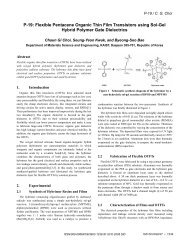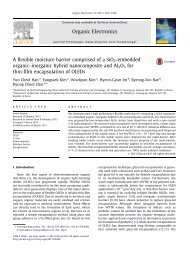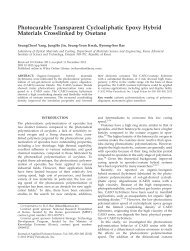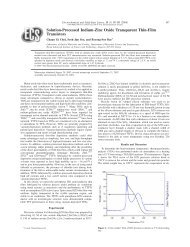Fabrication of transparent methacrylate zirconium siloxane hybrid ...
Fabrication of transparent methacrylate zirconium siloxane hybrid ...
Fabrication of transparent methacrylate zirconium siloxane hybrid ...
Create successful ePaper yourself
Turn your PDF publications into a flip-book with our unique Google optimized e-Paper software.
J Sol-Gel Sci Technol (2011) 58:114–120<br />
DOI 10.1007/s10971-010-2363-x<br />
ORIGINAL PAPER<br />
<strong>Fabrication</strong> <strong>of</strong> <strong>transparent</strong> <strong>methacrylate</strong> <strong>zirconium</strong> <strong>siloxane</strong><br />
<strong>hybrid</strong> materials using sol–gel synthesized oligo<strong>siloxane</strong> resin<br />
Jun-Young Bae • SeungCheol Yang •<br />
Jung Ho Jin • KyungHo Jung • Joon-Soo Kim •<br />
Byeong-Soo Bae<br />
Received: 26 August 2010 / Accepted: 10 November 2010 / Published online: 25 November 2010<br />
Ó Springer Science+Business Media, LLC 2010<br />
Abstract Methacrylate <strong>zirconium</strong> <strong>siloxane</strong> (MZS) resin<br />
was synthesized by a sol–gel reaction <strong>of</strong> 3-(trimethoxysilyl)propyl<br />
<strong>methacrylate</strong>, diphenylsilanediol, and <strong>zirconium</strong><br />
n-propoxide chelated with methacrylic acid. Also, propylene<br />
glycol monomethyl ether acetate was added as a solvent<br />
to synthesize a homogeneous and long-term stable<br />
resin by controlling the reactivity among the precursors.<br />
A High condensation degree <strong>of</strong> the resin and the formation<br />
<strong>of</strong> Si–O–Zr hetero-metal bonds were verified by 29 Si NMR<br />
and FT-IR spectroscopy. The MZS resin was spin-coated<br />
and photo-polymerized to fabricate a highly <strong>transparent</strong><br />
MZS hybrimer coating film. The refractive index and<br />
dielectric constant <strong>of</strong> the film increased according to the<br />
<strong>zirconium</strong> content, up to 1.59 and 3.65, respectively.<br />
Keywords Sol–gel <strong>hybrid</strong> material Methacrylate<br />
<strong>zirconium</strong> sioxane Degree <strong>of</strong> condensation Optical<br />
transparency High refractive index<br />
1 Introduction<br />
Sol–gel derived inorganic–organic <strong>hybrid</strong> materials (hybrimers)<br />
have been extensively researched, as they <strong>of</strong>fer<br />
combined benefits <strong>of</strong> both organic and inorganic characteristics<br />
[1–5]. Hybrimers, composed <strong>of</strong> a <strong>siloxane</strong> network<br />
formed by sol–gel condensation and a polymer network<br />
J.-Y. Bae S. Yang J. H. Jin K. Jung J.-S. Kim <br />
B.-S. Bae (&)<br />
Laboratory <strong>of</strong> Optical Materials and Coating (LOMC),<br />
Department <strong>of</strong> Materials Science and Engineering, Korea<br />
Advanced Institute <strong>of</strong> Science and Technology (KAIST),<br />
Daejeon 305-701, Republic <strong>of</strong> Korea<br />
e-mail: bsbae@kaist.ac.kr<br />
formed by organic polymerization at a molecular scale, are<br />
<strong>transparent</strong>, and more thermally and mechanically stable<br />
than general polymers. Given these characteristics, they<br />
have been studied for use as potential optical materials<br />
[6–8].<br />
Recently, we reported on <strong>siloxane</strong>-polymer hybrimers<br />
fabricated by curing <strong>of</strong> organo-oligo<strong>siloxane</strong> resin synthesized<br />
by a sol–gel reaction <strong>of</strong> organosilanes. The synthesized<br />
organo-oligo<strong>siloxane</strong> resin is mostly condensated and<br />
clear with long-term stability due to the absence <strong>of</strong><br />
hydroxyl radicals. Furthermore, they can be easily processed<br />
to produce coatings or bulk samples. Hybrimers<br />
fabricated via polymerization <strong>of</strong> the organo-oligo<strong>siloxane</strong><br />
resin are good candidates for various optical applications<br />
due to their excellent optical properties, such as high<br />
transparency, low optical loss, and low birefringence [2, 9–<br />
14]. The hybrimer also <strong>of</strong>fers easy tunability <strong>of</strong> optical and<br />
electrical characteristics by controlling the inorganic and<br />
organic compositions. Methacrylate hybrimers have been<br />
fabricated in previous studies by UV curing <strong>of</strong> <strong>methacrylate</strong><br />
phenyl oligo<strong>siloxane</strong> synthesized by sol–gel condensation<br />
<strong>of</strong> 3-(trimethoxysilyl)propyl <strong>methacrylate</strong> (MPTS)<br />
and diphenylsilanediol (DPSD) [9, 12]. The hybrimer has<br />
excellent transparency and a high refractive index (up to<br />
1.56) due to the presence <strong>of</strong> phenyl groups, allowing versatility<br />
in the design <strong>of</strong> components and materials in microoptical<br />
devices such as optical coatings, micro-lens,<br />
waveguides, etc.<br />
These hybrimers, however, have a low dielectric constant<br />
due to the existence <strong>of</strong> symmetrical phenyl groups<br />
[13]. Thus, it is necessary to increase the refractive index<br />
and dielectric constant while maintaining molecular<br />
homogeneity so that they can be effectively utilized in<br />
optics and electronics. The simplest method to accomplish<br />
this is to add metal (<strong>zirconium</strong> or titanium) alkoxides<br />
123
J Sol-Gel Sci Technol (2011) 58:114–120 115<br />
during fabrication <strong>of</strong> the hybrimer. However, a precursor<br />
solution containing metal alkoxides is not sufficiently stable<br />
to fabricate <strong>transparent</strong> and homogeneous <strong>hybrid</strong><br />
materials via a sol–gel process due to the active reactivity<br />
<strong>of</strong> the metal alkoxides. Therefore, preparation <strong>of</strong> a stable<br />
and homogeneous precursor solution containing metal for<br />
fabrication <strong>of</strong> hetero-metal <strong>siloxane</strong> <strong>hybrid</strong> materials is an<br />
important area <strong>of</strong> research [15–20].<br />
In this study, we synthesized <strong>methacrylate</strong>-<strong>zirconium</strong>oligo<strong>siloxane</strong><br />
resin by sol–gel reaction <strong>of</strong> 3-(trimethoxysilyl)propyl<br />
<strong>methacrylate</strong> (MPTS), diphenylsilanediol<br />
(DPSD) and <strong>zirconium</strong> n-propoxide (ZPO) without adding<br />
water, as represented in Scheme 1a. Instead <strong>of</strong> titanium, we<br />
incorporated a <strong>zirconium</strong> precursor, since it does not<br />
undergo any catalytic photodegradation <strong>of</strong> organic groups<br />
[20]. Methacrylic acid (MAA) was used as a chelating<br />
agent in the presence <strong>of</strong> a solvent (PGMEA) to increase the<br />
degree <strong>of</strong> condensation and homogeneity. The formation<br />
and condensation <strong>of</strong> Si–O–Zr hetero-metal bonds were<br />
thereby promoted during the sol–gel reaction. The synthesized<br />
oligo<strong>siloxane</strong> resin was spin-coated and UV-cured<br />
to fabricate a <strong>methacrylate</strong> <strong>zirconium</strong> <strong>siloxane</strong> <strong>hybrid</strong><br />
(MZS hybrimer) coating film, as described in Scheme 1b.<br />
It was found that the refractive index and dielectric<br />
constant <strong>of</strong> the hybrimer coating film increases according<br />
to the Zr content.<br />
2 Experimental<br />
2.1 Synthesis <strong>of</strong> <strong>methacrylate</strong> <strong>zirconium</strong> <strong>siloxane</strong><br />
(MZS) resin<br />
Methacrylate <strong>zirconium</strong> oligo<strong>siloxane</strong> resin was synthesized<br />
by a solvent assisted sol–gel condensation reaction <strong>of</strong><br />
3-(trimethoxysilyl)propyl <strong>methacrylate</strong> (MPTS, Aldrich),<br />
diphenylsilanediol (DPSD, Gelest), and <strong>zirconium</strong> n-<br />
propoxide (ZPO, 70% solution in propanol, Aldrich) in<br />
molar ratio <strong>of</strong> 4:6:0, 3:6:1, 2:6:2 and 1:6:3, respectively.<br />
The content <strong>of</strong> the DPSD precursor was fixed at 0.09 mol<br />
and ZPO content was increased from 0 to 0.045 mol while<br />
the MPTS content was decreased from 0.06 to 0.015 mol,<br />
as listed in Table 1. In advance, ZPO was chelated by<br />
methacrylic acid (MAA, Aldrich) with a molar ratio <strong>of</strong> 2:1<br />
to balance the reactivity between MPTS and ZPO. After<br />
1 h stirring, MPTS was added to the chelated ZPO and<br />
stirred for a further 20 min at room temperature. Also,<br />
DPSD was dissolved in propylene glycol monomethyl<br />
Scheme 1 a Synthesis <strong>of</strong> <strong>methacrylate</strong> <strong>zirconium</strong> oligo<strong>siloxane</strong> resin by a solvent assisted sol–gel condensation <strong>of</strong> MPTS, ZPO and DPSD and<br />
b fabrication <strong>of</strong> <strong>methacrylate</strong> <strong>zirconium</strong> <strong>siloxane</strong> <strong>hybrid</strong> material (MZS hybrimer)<br />
Table 1 Compositions <strong>of</strong> chemicals for synthesis <strong>of</strong> <strong>methacrylate</strong> <strong>zirconium</strong> <strong>siloxane</strong> resin<br />
MPTS (g) DPSD (g) Zirconium<br />
n-propoxide (g)<br />
Ba(OH) 2 H 2 O (g)<br />
PGMEA (g)<br />
14.9 (0.06 mol) 19.47 (0.09 mol) 0 0.057 58.41<br />
11.18 (0.045 mol) 19.47 (0.09 mol) 7.02 (0.015 mol) 0.057 58.41<br />
7.45 (0.03 mol) 19.47 (0.09 mol) 14.04 (0.03 mol) 0.057 58.41<br />
3.73 (0.015 mol) 19.47 (0.09 mol) 21.06 (0.045 mol) 0.057 58.41<br />
123
116 J Sol-Gel Sci Technol (2011) 58:114–120<br />
ether acetate (PGMEA, Aldrich) at 80 °C with a 3:1 weight<br />
ratio, yielding a clear solution. The DPSD solution was<br />
then slowly mixed with the mixture <strong>of</strong> MPTS and ZPO.<br />
The condensation reaction <strong>of</strong> the mixed solution was performed<br />
at 80 °C in the presence <strong>of</strong> a catalyst, 0.2 mol% <strong>of</strong><br />
barium hydroxide monohydrate [Ba(OH) 2 H 2 O, Aldrich],<br />
for 10 h. After the reaction, the synthesized resin was filtered<br />
through a 0.45 lm Teflon filter to remove the catalysts.<br />
Also, by-product <strong>of</strong> the condensation reaction<br />
(methanol) and residual solvent were removed by vacuum<br />
heating at 60 °C.<br />
2.2 <strong>Fabrication</strong> <strong>of</strong> <strong>methacrylate</strong> <strong>zirconium</strong> <strong>siloxane</strong><br />
(MZS) hybrimer film<br />
To fabricate the MZS hybrimer coating film, 2,2-dimethoxy-2-phenyl-acetophenone<br />
(BDK, Aldrich) was added<br />
to the synthesized resin as a photo-initiator for photopolymerization<br />
<strong>of</strong> the <strong>methacrylate</strong> groups, as illustrated in<br />
Scheme 1b. The content <strong>of</strong> BDK was 2 wt% <strong>of</strong> the entire<br />
resin. The resin was diluted by PGMEA to reduce its viscosity<br />
for easier fabrication <strong>of</strong> the coating film. The weight<br />
ratio <strong>of</strong> MZS resin to PGMEA was 1:1. The diluted resin<br />
was then stirred at room temperature for 8 h and spincoated<br />
at 2,000 rpm for 30 s on various substrates (soda<br />
lime glass, ITO glass, and Si wafer). The coated film was<br />
photo-cured using an ultraviolet (UV) lamp (500 W Hg<br />
Lamp, *365 nm, Oriel 97453) in a N 2 atmosphere for<br />
3 min. In order to evaporate the residual solvent and nonpolymerized<br />
organic groups, the film was baked at 150 °C<br />
for 2 h. The baking was performed in a vacuum oven<br />
to prevent formation <strong>of</strong> cracks inside the film. After<br />
UV-curing and baking, a dense and smooth coating film<br />
with high refractive index was successfully fabricated.<br />
was coated on ITO glass to measure its dielectric constant.<br />
Circular gold electrodes having a radius <strong>of</strong> 0.54 nm were<br />
deposited by thermal evaporation at a rate <strong>of</strong> 0.5Å min -1 .<br />
The dielectric constant was measured with an HP4194A<br />
(Agilent Technologies) impedance/gain analyzer and a<br />
Keithley 237 source-measure unit (Keithley). The optical<br />
transmittance <strong>of</strong> the film coated on a quartz substrate was<br />
obtained in a wavelength range from 300 to 800 nm using<br />
an UltraViolet–Visible (UV–Vis) spectrophotometer (Shimadzu,<br />
UV3010 PC). Finally, cross-sectional photographs<br />
<strong>of</strong> the coating film were taken by Scanning Electron<br />
Microscopy (SEM, Hitachi S-4800) and the surface morphology<br />
was also examined using Atomic Force Microscopy<br />
(AFM, SEIKO).<br />
3 Results and discussion<br />
3.1 Formation <strong>of</strong> highly condensed <strong>methacrylate</strong><br />
<strong>zirconium</strong> oligo<strong>siloxane</strong> resin<br />
29 Si NMR spectra <strong>of</strong> the synthesized oligo<strong>siloxane</strong>s are<br />
shown in Fig. 1 to show the condensation behavior<br />
depending on <strong>zirconium</strong> content. The nomenclatures, T n<br />
and D n , are assigned to Si atoms <strong>of</strong> MPTS and DPSD in the<br />
oligo<strong>siloxane</strong> structure, as shown in Fig. 2. The superscript,<br />
n, denotes the number <strong>of</strong> <strong>siloxane</strong> bonds attached to<br />
Si atoms. Degree <strong>of</strong> chemical shifts can be assigned as D 0<br />
(-29 ppm), D 1 (-36 to -38 ppm), D 2 (-42 to -47 ppm),<br />
2.3 Characterization <strong>of</strong> oligo<strong>siloxane</strong> resin<br />
and hybrimer<br />
The condensation behavior and formation <strong>of</strong> Si–O–Zr hetero-metal<br />
bonds in the oligo<strong>siloxane</strong> resin were examined<br />
through 29 Si Nuclear Magnetic Resonance (NMR) spectroscopy<br />
and Fourier Transform-InfraRed (FT-IR) spectroscopy<br />
(JASCO, FT-IR 460plus). 29 Si NMR spectra <strong>of</strong> the<br />
MZS resin in 30 vol% <strong>of</strong> chlor<strong>of</strong>orm-d were analyzed using<br />
a FT 600 MHz (Bruker Biospin DMX600) instrument.<br />
Chromium (III) acetylacetonate was added as a relaxation<br />
agent with a concentration <strong>of</strong> 30 mg/L. Also, we performed<br />
FT-IR spectra analysis in solution with a resolution <strong>of</strong><br />
4cm -1 in a wavenumber range <strong>of</strong> 650–4,000 cm -1 .<br />
The refractive index <strong>of</strong> the MZS hybrimer film coated<br />
on the Si wafer was obtained by a prism coupler (Pennington,<br />
Metricon 2010) at a 633 nm wavelength. The film<br />
Fig. 1 29 Si NMR spectra <strong>of</strong> <strong>methacrylate</strong> <strong>zirconium</strong> oligo<strong>siloxane</strong><br />
resins according to the Zr content<br />
123
J Sol-Gel Sci Technol (2011) 58:114–120 117<br />
Table 2 Degree <strong>of</strong> condensation <strong>of</strong> <strong>methacrylate</strong> <strong>zirconium</strong> oligo<strong>siloxane</strong><br />
resin and characteristics <strong>of</strong> MZS hybimer coating film<br />
Zr content<br />
(atom %)<br />
DOC<br />
(%)<br />
Refractive<br />
index<br />
(@633 nm)<br />
Dielectric<br />
constant<br />
(@1 MHz)<br />
Transmittance<br />
(@450 nm, %)<br />
0 78.5 1.563 2.98 98.9<br />
10 85.3 1.574 3.39 97.5<br />
20 88.8 1.584 3.50 97.7<br />
30 96.8 1.591 3.65 97.3<br />
Fig. 2 Nomenclature, T n<br />
oligo<strong>siloxane</strong> resin<br />
and D n , in 29 Si NMR spectra <strong>of</strong> the<br />
T 1 (-49 to -51), T 2 (-57 to -61 ppm) and T 3 (-65 to<br />
-69 ppm), respectively.<br />
In the spectra, the band <strong>of</strong> the major condensed product<br />
was detected at D 2 , and this band verifies high degree <strong>of</strong><br />
condensation <strong>of</strong> the MZS resins. The intensity <strong>of</strong> the D 2<br />
bands gradually increases with a reduction <strong>of</strong> the D 1 and T 1<br />
bands as the Zr content is varied from 10 to 30 atom%.<br />
Also, considerable bandwidth broadening <strong>of</strong> bands, which<br />
indicates the incorporatation <strong>of</strong> Zr in the <strong>siloxane</strong> network,<br />
is detected [21, 22]. The bands shift to a lower field due to<br />
the formation <strong>of</strong> Si–O–Zr hetero-metal bonds. As shown in<br />
Fig. 1, there is a field shift (-1 to-3 ppm) <strong>of</strong> D n /T n bands<br />
and this effect is maximized in the D 2 bands <strong>of</strong> the resin<br />
with 30 atom% Zr. Therefore, we could conclude that Zr<br />
was successfully incorporated in the oligo<strong>siloxane</strong> structure<br />
and there exists mostly condensed D n /T n species inside the<br />
MZS resin. The degree <strong>of</strong> condensation <strong>of</strong> the resin can be<br />
calculated by the following equation [14].<br />
DOC ¼<br />
D 1 þ2D 2 þT 1 þ2T 2 þ3T 3<br />
2ðD 0 +D 1 +D 2 Þ + 3(T 0 +T 1 +T 2 +T 3 Þ 100<br />
Table 2 shows the degree <strong>of</strong> condensation <strong>of</strong> MZS resin<br />
depending on the resin composition. The degree <strong>of</strong><br />
condensation increases up to 96.8% with an increase <strong>of</strong><br />
Zr content up to 30 atom%.<br />
Figure 3 shows FT-IR spectra <strong>of</strong> MZS resins, presenting<br />
further evidence <strong>of</strong> the formation <strong>of</strong> Si–O–Zr bonds, where<br />
Zr content is varied from 0 to 30 atom%. We could not<br />
detect any hydroxyl groups in the spectral regions <strong>of</strong><br />
3,600–3,200 cm -1 , assigned to (-OH) vibration <strong>of</strong> Si–OH.<br />
This finding shows that hydroxyl groups are completely<br />
removed during the reaction. In the presence <strong>of</strong> Zr, the<br />
intensity <strong>of</strong> the bands at 2,840 cm -1 , which is assigned to<br />
the methoxy (Si-OCH 3 ) group, considerably decreases due<br />
to complete reaction among the precursors [11]. This<br />
Fig. 3 FT-IR spectra <strong>of</strong> MZS resins according to the Zr content in a<br />
wavenumber range <strong>of</strong> (a) 2,700–3,300 cm -1 and (b) 650–1,450 cm -1 ,<br />
where Si–O–Si bonds at 1,065 cm -1 and Si–O–Zr bonds at 940 cm -1<br />
123
118 J Sol-Gel Sci Technol (2011) 58:114–120<br />
indicates that methoxy groups are changed into Si–O–Zr<br />
bonds due to the promoted condensation reaction when Zr<br />
is incorporated.<br />
In the spectra, a sharp peak at 1,110 cm -1 and a broad<br />
band at around 1,065 cm -1 represent the Si–O–Si asymmetric<br />
stretching mode [10]. On the other hand, the bands<br />
at 940 cm -1 are assigned to Si–O–Zr hetero-metal bonds<br />
[23–25]. As Zr content is increased from 0 atom% to 30<br />
atom%, the relative intensity <strong>of</strong> Si–O–Zr bands, increases<br />
relative to the intensity <strong>of</strong> Si–O–Si bands. Also, the broad<br />
bands at 1,065 cm -1 shift slightly toward bands at<br />
1,048 cm -1 with increasing Zr up to 30 atom%. This is<br />
attributed to a field shift <strong>of</strong> Si–O–Si bands at 1,065 cm -1<br />
towards lower wavenumber resulting from the formation <strong>of</strong><br />
Si–O–Zr bonds [26]. These band intensity increase and the<br />
band position shift is consistent with the hypothesis that the<br />
formation <strong>of</strong> Si–O–Zr hetero-metal bonds is promoted<br />
depending on the amount <strong>of</strong> Zr.<br />
Successful formation <strong>of</strong> highly condensed MZS resin<br />
was achieved by a sol–gel condensation reaction. Si–O–Zr<br />
hetero-metal bonds were well formed in the resin by a<br />
condensation reaction among the methoxy group <strong>of</strong> MPTS,<br />
the silanol group <strong>of</strong> DPSD, and the propyl group <strong>of</strong> ZPO.<br />
The ZPO modified by MAA leading to hexacoordinated Zr<br />
precursors increase the degree <strong>of</strong> condensation (Table 2)<strong>of</strong><br />
<strong>zirconium</strong>-oligo<strong>siloxane</strong> resin as compared to pure oligo<strong>siloxane</strong><br />
resin [21, 22].<br />
In the presence <strong>of</strong> Zr, it is difficult to match hydrolysis/<br />
condensation rates for synthesizing homogeneous and stable<br />
MZS resin, because the reactivities <strong>of</strong> Si and Zr alkoxides<br />
are different. Thus, a chelating agent (MAA) was<br />
added to produce more Si–O–Zr bonds and to prevent the<br />
formation <strong>of</strong> Zr–O–Zr bonds [20]. However, addition <strong>of</strong><br />
this agent was not sufficient for controlling the reaction in<br />
the presence <strong>of</strong> large amounts <strong>of</strong> <strong>zirconium</strong> alkoxide ([20<br />
atom%). Therefore, we also used a solvent (PGMEA) as a<br />
reaction medium to reduce the reaction rate by dilution.<br />
Since the reaction rate is function <strong>of</strong> the concentration <strong>of</strong><br />
the reactants which depends on the amount <strong>of</strong> solvent.<br />
Through the solvent assisted sol–gel reaction, the synthesized<br />
MZS resin shows good long-term stability and a high<br />
degree <strong>of</strong> condensation degree [11], as evidenced by liquid<br />
state 29 Si NMR and FT-IR investigations.<br />
In the reaction, the solvent acts as a reaction medium to<br />
promote formation <strong>of</strong> Si–O–Zr bonds which is due to the<br />
reaction <strong>of</strong> Si–OH and ZrOR. Since Zr is more electrophilic<br />
than Si, Si–OH reacts more slowly with Si-OR. Also,<br />
Zr–O–Zr bonds can be formed due to hydrolysis <strong>of</strong> Zr-OR<br />
by trace <strong>of</strong> moisture or by ligand exchange with Si–OH.<br />
Zr–O–Zr bonds can also result from exchange between<br />
Si–O–Zr bonds to give Si–O–Si and Zr–O–Zr, for thermodynamic<br />
reasons. Due to the difference in electronegativities<br />
between Si and Zr, already formed Si–O–Zr bonds<br />
are more polar compared to Si–O–Si bonds. More polar<br />
bonds induce preferred nucleophillic attack <strong>of</strong> silanol<br />
groups in DPSD [18]. Once Si–O–Zr bonds commences,<br />
the formation <strong>of</strong> the hetero-metal bonds is consistently<br />
promoted and self-condensation is relatively prohibited<br />
[21]. As a result, homogeneously dispersed Si–O–Zr bonds<br />
exists in the oligo<strong>siloxane</strong> structure.<br />
3.2 Optical and electrical characteristics <strong>of</strong> MZS<br />
hybrimer coating films<br />
As shown in Scheme. 1b, highly cross-linked MZS hybrimer<br />
is fabricated by photo-polymerization <strong>of</strong> <strong>methacrylate</strong><br />
groups between <strong>zirconium</strong>-oligo<strong>siloxane</strong>s. The resin is then<br />
spin-coated on soda lime glass, Si wafer, and ITO glass to<br />
measure optical and electrical characteristics <strong>of</strong> the coating<br />
films. The optical transmittance, refractive index, and<br />
dielectric constant <strong>of</strong> the fabricated films are listed in<br />
Table 2 according to the Zr content.<br />
As shown in Fig. 4a, the film is highly <strong>transparent</strong> for<br />
application to various optical devices. It shows excellent<br />
transparency over 95% in the visible range regardless <strong>of</strong><br />
the Zr content. In addition, it is also colorless even when<br />
the Zr content is maximized to 30 atom%. In the presence<br />
<strong>of</strong> Zr, high molecular weight <strong>zirconium</strong>-oligo<strong>siloxane</strong><br />
exists inside the MZS resin, since ZPO has larger molecular<br />
weight than MPTS. These large size molecules prevent<br />
photo-polymerization <strong>of</strong> <strong>methacrylate</strong> groups due to large<br />
steric hindrance [12]. Therefore, the optical transmittance<br />
at a wavelength <strong>of</strong> 450 nm falls slightly due to hindered<br />
cross-linking <strong>of</strong> MZS networks (Table 2).<br />
Also, the MZS hybrimer coating film shows excellent<br />
coating quality, which results in a smooth surface and good<br />
adhesion to the substrate, as shown in the cross-sectional<br />
SEM image presented in Fig. 4b, c presents an AFM<br />
micrograph <strong>of</strong> the coating film containing 30 atom% Zr.<br />
From the image, information on the surface roughness can<br />
be obtained. Root-mean-square (rms) surface roughness<br />
was measured using AFM line pr<strong>of</strong>ile data and a value <strong>of</strong><br />
5.56 9 10 -1 nm was obtained in the case <strong>of</strong> 30 atom% Zr<br />
content. This value (rms \ 1 nm) verifies surface <strong>of</strong> MZS<br />
hybrimer film is considerably smooth. Refractive index <strong>of</strong><br />
the MZS hybrimer coating film according to the Zr content<br />
was also measured at a wavelength <strong>of</strong> 633 nm, as shown in<br />
Fig. 5. A high refractive index is an important factor to<br />
develop optically efficient devices. Compared to conventional<br />
<strong>methacrylate</strong> <strong>siloxane</strong> films fabricated in our laboratory,<br />
the refractive index <strong>of</strong> MZS hybrimer film<br />
considerably increases up to 1.59 in the presence <strong>of</strong> Zr<br />
[14]. As represented in Fig. 5, the refractive index varies<br />
from 1.56 to 1.59 with increasing Zr content.<br />
The difference in the refractive index <strong>of</strong> the films is<br />
caused by the microstructure and phase transformations <strong>of</strong><br />
123
J Sol-Gel Sci Technol (2011) 58:114–120 119<br />
Fig. 4 a UV–Vis spectra<br />
according to the Zr content and<br />
photograph <strong>of</strong> the MZS resin<br />
with 30 atom% <strong>of</strong> Zr, b crosssectional<br />
SEM image and<br />
c AFM surface image <strong>of</strong> MZS<br />
film with 30 atom% <strong>of</strong> Zr<br />
O–Zr hetero-metal bonds in order to increase the refractive<br />
index compared to a pure <strong>siloxane</strong> network. The refractive<br />
index n can be calculated by the following Lorentz-Lorenz<br />
equation [14].<br />
Fig. 5 Refractive index and dielectric constant <strong>of</strong> MZS hybrimer<br />
coating film according to the Zr content<br />
precursor molecules [27]. General fabrication methods<br />
require high temperature, which can harm organic groups<br />
in <strong>hybrid</strong> materials. Thus, we focus on the formation <strong>of</strong> Si–<br />
n 2 1<br />
n 2 þ 2 ¼ 4p 3 Na<br />
where n is the refractive index, N is the number <strong>of</strong> molecules<br />
per unit volume, and a is the mean polarizability.<br />
According to the equation, a dense film that has high<br />
polarizability shows a high refractive index. In the case <strong>of</strong><br />
MZS film, there are phenyl groups in DPSD, which shows<br />
high electronic polarizability [28, 29]. Furthermore, a<br />
sufficient amount <strong>of</strong> highly polarizable Si–O–Zr bonds are<br />
formed when Zr content reaches 30 atom%, as already<br />
verified by the FT-IR analysis. Also, photo-polymerization<br />
and a thermal curing process can facilitate densification <strong>of</strong><br />
the film and thereby increase the refractive index [14].<br />
123
120 J Sol-Gel Sci Technol (2011) 58:114–120<br />
A SEM image <strong>of</strong> a dense and crack-free MZS hybrimer<br />
coating film is shown in Fig. 4b. Although the film contains<br />
a large amount <strong>of</strong> Zr (30 atom%), it is well coated with a<br />
smooth surface as shown in the SEM/AFM images.<br />
The thickness <strong>of</strong> the film was also optimized at 2.14 lm<br />
to characterize the dielectric constant (Fig. 4b). The<br />
dielectric constant was measured by an impedance/gain<br />
analyzer and was found to depend on the Zr content. As<br />
shown in Fig. 5, the dielectric constant <strong>of</strong> the MZS hybrimer<br />
film at 1 MHz changes from 2.98 to 3.65 with<br />
respect to a change <strong>of</strong> the content <strong>of</strong> Zr from 0 to 30<br />
atom%. Tunability <strong>of</strong> the dielectric constant is useful for<br />
many optical applications. We can also incorporate various<br />
precursors such as fluorine inside <strong>methacrylate</strong> oligo<strong>siloxane</strong><br />
to reduce the dielectric constant. The MZS<br />
hybrimer shows a relatively high dielectric constant compared<br />
to <strong>methacrylate</strong> hybrimer (e = 2.98) and fluorinated<br />
<strong>methacrylate</strong> hybrimer (e = 2.54). Note also that the<br />
dielectric constant is closely related to the refractive index,<br />
as simply shown in the following equation [13].<br />
e ¼ n 2<br />
where e represents the dielectric constant and n represents<br />
the refractive index. Thus, the dielectric constant is also<br />
related to polarizability and density <strong>of</strong> the film. Similar to<br />
the case <strong>of</strong> the refractive index, more polar Si–O–Zr bonds<br />
as compared to Si–O–Si bonds can increase the dielectric<br />
constant according to the amount <strong>of</strong> Zr. As already noted in<br />
this paper, densification <strong>of</strong> the film also increases the<br />
refractive index and transparency. A smooth, adhesive, and<br />
dense MZS hybrimer coating film was successfully fabricated<br />
without cracks, thus yielding superior optical and<br />
electrical properties.<br />
4 Conclusion<br />
Highly hetero-condensed <strong>methacrylate</strong> <strong>zirconium</strong> <strong>siloxane</strong><br />
<strong>hybrid</strong> materials (MZS hybrimers) were successfully synthesized<br />
through a solvent assisted sol–gel process. Zr<br />
content was increased up to 30 atom% <strong>of</strong> the entire resin. It<br />
was verified that solvent promote balanced condensation<br />
reaction among precursors by dilution. In the presence <strong>of</strong><br />
solvent the reaction rate decreased by diluted concentration<br />
<strong>of</strong> the precursors. Also, Zr alkoxide modified by chelating<br />
agent increases the degree <strong>of</strong> condensation and enhances<br />
the formation <strong>of</strong> hetero-metal Si–O–Zr bonds at a molecular<br />
scale. A MZS hybrimer coating film was also fabricated<br />
by a photo-polymerization and thermal baking. The<br />
film showed excellent transparency and high a refractive<br />
index, which are attributed to the high polarizability <strong>of</strong> Si–<br />
O–Zr bonds. The refractive index <strong>of</strong> the film increased<br />
from 1.56 to 1.59 according to the Zr content. Also, the<br />
electrical properties such as dielectric constant were characterized.<br />
Therefore, the MZS hybrimer coating films are a<br />
suitable candidate for various optical devices and materials<br />
such as optical coatings, micro-lens, gratings, and<br />
waveguides.<br />
Acknowledgments This work was supported by the Industrial<br />
Strategic technology development program, (10006932, Development<br />
<strong>of</strong> Large Optical Waveguide Components for Touch Screen Panel<br />
Using Sol–Gel Molding Technique) funded by the Ministry <strong>of</strong><br />
Knowledge Economy (MKE, Korea).<br />
References<br />
1. Schmidt H, Jonschker G, Goedicke S, Mennig M (2000) J Sol-<br />
Gel Sci Technol 19:39<br />
2. Schubert U, Husing N, Lorenz A (1995) Chem Mater 7:2010<br />
3. Vioux A (1997) Chem Mater 9:2292<br />
4. Sharp KG (1998) Adv Mater 10(15):1243<br />
5. Oubaha M, Etienne P, Calas S, Sempere R, Nedelec JM, Moreau<br />
Y (2005) J Non-Cryst Solids 351:2122<br />
6. Buestrich R, Kahlenberg F, Popall M (2001) J Sol-Gel Sci<br />
Technol 20:181<br />
7. Popall M, Buestrich R, Kahlenberg F, Adersson A, Haglund J,<br />
Robertsson ME, Blau G, Gale M, Rösch O, Dabek A, Neumann-<br />
Rodekirch J, Cergel L, Lambert D (2000) Mater Res Soc Symp<br />
Proc 628:CC9.8.1<br />
8. Lebeau B, Sanchez C (1999) Current Opinion Solid State Mat Sci<br />
4(1):11<br />
9. Eo YJ, Lee TH, Kim SY, Kang JK, Han YS, Bae BS (2005)<br />
J Polym Sci, Part B: Polym phys 43:827<br />
10. Kang DJ, Bae BS (2008) J Non-Cryst Solids 354:4975<br />
11. Yang SC, Kwak SY, Jin JH, Bae BS (2009) ACS Appl Mater &<br />
Interfaces 1(7):1585<br />
12. Kim JS, Yang SC, Bae BS (2010) J Sol-Gel Sci Technol 53:434<br />
13. Oh JH, Kwak SY, Yang SC, Bae BS (2010) ACS Appl Mater &<br />
Interfaces 2(3):913<br />
14. Eo YJ, Kim JH, Ko JH, Bae BS (2005) J Mater Res 20:401<br />
15. Lee LH, Hen WC (2001) Chem Mater 13:1137<br />
16. Oubaha M, Etienne P, Calas S, Coudray P, Nedelec JM, Moreau<br />
Y (2005) J Sol-Gel Sci Technol 33(2):241<br />
17. Xiao Z, Haijing L, Soutar A, Xianting Z (2003) Elect Packag<br />
Technol Conf 744<br />
18. Monte FD, Cheben P, Grover CP, Mackenzie JD (1999) J Sol-Gel<br />
Sci Technol 15:73<br />
19. Hoebbel D, Reinert T, Schmidt H (1996) J Sol-Gel Sci Technol<br />
6:139<br />
20. Sorek Y, Zevin M, Reisfeld R, Hurvits T, Ruschin S (1997) Chem<br />
Mater 9:670<br />
21. Hoebbel D, Reinert T, Schmidt H (1996) J Sol-Gel Sci Technol<br />
7:217<br />
22. Nacken M, Hoebbel D, Schmidt H (1999) Mater Res Soc Symp<br />
Proc 576:221<br />
23. Lee SW, Condrate RA (1988) J Mater Sci 23:2951<br />
24. Du XM, Almeida RM (1997) J Sol-Gel Sci Technol 8:377<br />
25. Vasconcelos HC (2010) J Sol-Gel Sci Technol 55:126<br />
26. Zhan Z, Zeng HC (1999) J Non-Cryst Solids 243:26<br />
27. Liu WC, Wu D, Li AD, Ling HQ, Tang YF, Ming NB (2002)<br />
Appl Surf Sci 181<br />
28. Kang ES, Park JU, Bae BS (2003) J Mater Res 18:1889<br />
29. Park OH, Seo SY, Jung JI, Bae JY, Bae BS (2003) J Mater Res<br />
18:1039<br />
123







